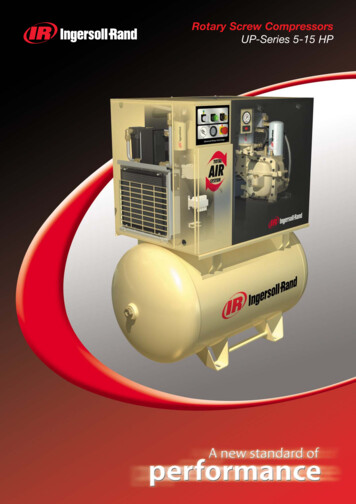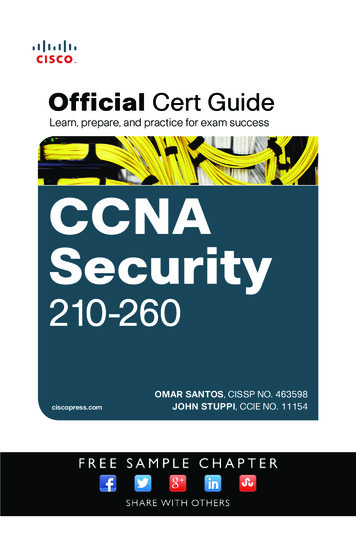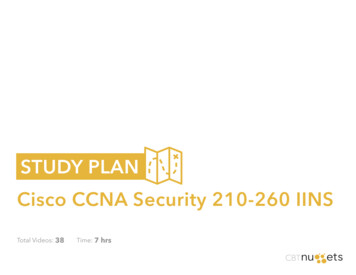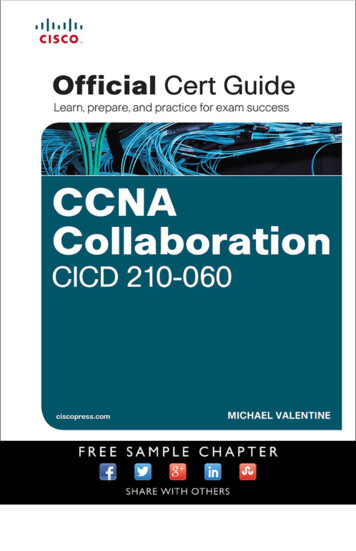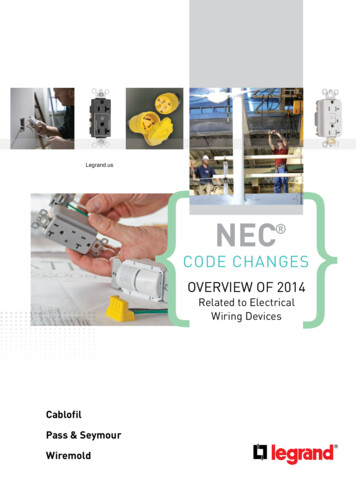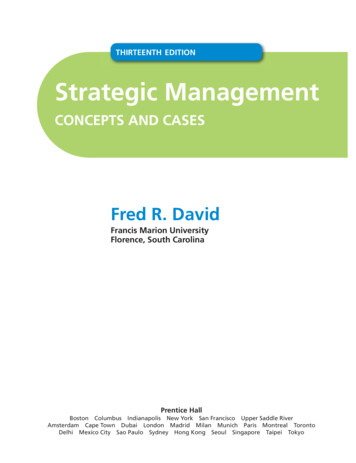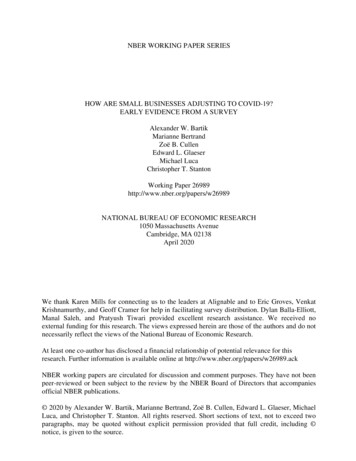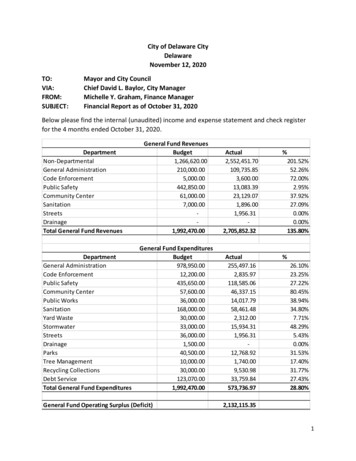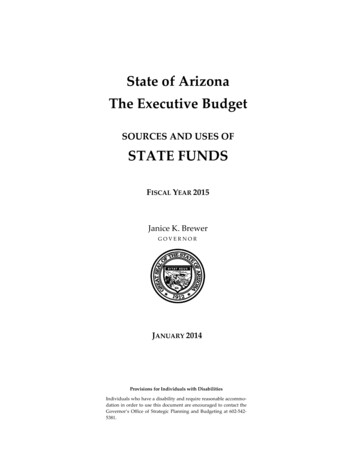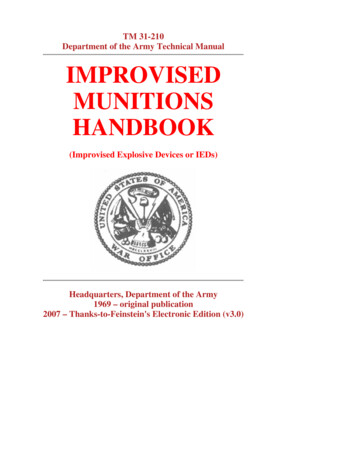
Transcription
TM 31-210Department of the Army Technical ManualIMPROVISEDMUNITIONSHANDBOOK(Improvised Explosive Devices or IEDs)Headquarters, Department of the Army1969 – original publication2007 – Thanks-to-Feinstein's Electronic Edition (v3.0)
Improvised Munitions Handbook (Improvised Explosive Devices or IEDs)Table of ContentsSection 0 — Introduction0.1 Purpose and Scope0.2 Safety and Reliability0.3 User CommentsSection 1 — Explosives and Propellants (including igniters)1.1 Plastic Explosive Filler1.2 Potassium Nitrate1.3 Improvised Black Powder1.4 Nitric Acid1.5 Initiator for Dust Explosions1.6 Fertilizer Explosive1.7 Carbon Tet – Explosive1.8 Fertilizer AN-Al Explosive1.9 “Red or White Powder” Propellant1.10 Nitric Acid/Nitrobenzene (“Hellhoffite”) Explosive1.11 Optimized Process for Cellulose/Acid Explosives1.12 Methyl Nitrate Dynamite1.13 Urea Nitrate Explosive1.14 Preparation of Copper Sulfate (Pentahydrate)1.15 Reclamation of RDX from C41.16 TACC (Tetramminecopper (II) Chlorate)1.17 HMTD1.18 Potassium or Sodium Nitrite and Litharge (Lead Monoxide)1.19 DDNP1.20 Preparation of Lead Picrate1.21 Preparation of Picric Acid from Aspirin1.22 Double Salts1.23 Sodium Chlorate1.24 Mercury Fulminate
1.25 Sodium Chlorate and Sugar or Aluminum ExplosiveSection 2 — Mines and Grenades2.1 Pipe Hand Grenade2.2 Nail Grenade2.3 Wine Bottle Cone Charge2.4 Grenade-Tin Can Land Mine2.5 Mortar Scrap Mine2.6 Coke Bottle Shaped Charge2.7 Cylindrical Cavity Shaped Charge2.8 Not Available2.9 Funnel Shaped Charge2.10 Linear Shaped ChargeSection 3 — Small Arms Weapons and Ammunition3.1 Pipe Pistol for 9 mm Ammunition3.2 Shotgun (12 gauge)3.3 Shotshell Dispersion Control3.4 Carbine (7.62 mm Standard Rifle Ammunition)3.5 Reusable Primer3.6 Pipe Pistol for .45 Caliber Ammunition3.7 Match Gun3.8 Rifle Cartridge3.9 Pipe Pistol for .38 Caliber Ammunition3.10 Pipe Pistol for .22 Caliber Ammunition — Long or Short Cartridge3.11 Low Signature SystemSection 4 — Mortars and Rockets4.1 Recoilless Launcher4.2 Shotgun Grenade Launcher4.3 Grenade Launcher (57 mm Cardboard Container)4.4 Fire Bottle Launcher4.5 Grenade Launchers4.6 60 mm Mortar Projectile LauncherSection 5 — Incendiary Devices5.1 Chemical Fire Bottle5.2 Igniter from Book Matches5.3 Mechanically Initiated Fire Bottle
5.4 Gelled Flame Fuels5.4.1 Lye Systems5.4.2 Lye-Alcohol Systems5.4.3 Soap-Alcohol System5.4.4 Egg White Systems5.4.5 Latex Systems5.4.6 Wax Systems5.4.7 Animal Blood Systems5.5 Acid Delay Incendiary5.6 Improvised White Flare5.7 Improvised Iron Oxide5.8 Improvised Yellow Flare5.9 Improvised White Smoke Munition5.10 Improvised Black Smoke MunitionSection 6 — Fuses, Detonators & Delay Mechanisms6.1 Electric Bulb Initiator6.2 Fuse Igniter from Book Matches6.3 Delay Igniter from Cigarette6.4 Watch Delay Timer6.5 No-Flash Fuse Igniter6.6 Dried Seed Timer6.7 Fuse Cords6.7.1 Fast Burning Fuse6.7.2 Slow Burning Fuse6.8 Clothespin Time Delay Switch6.9 Time Delay Grenade6.10 Can-Liquid Time Delay6.11 Short Term Time Delay for Grenade6.12 Long Term Time Delay for Grenade6.13 DetonatorSection 7 — Miscellaneous7.1 Clothespin Switch7.2 Mousetrap Switch7.3 Flexible Plate Switch7.4 Metal Ball Switch
7.5 Altimeter Switch7.6 Pull-Loop Switch7.7 Knife Switch7.8 Improvised Scale7.9 Rope Grenade Launching Technique7.10 Bicycle Generator Power Source7.11 Automobile Generator Power Source7.12 Improvised Battery (Short Lasting)7.13 Improvised Battery (2 Hour Duration)7.14 Armor MaterialsAppendix 1 — Primary High ExplosivesA1.1 Mercury FulminateA1.2 Lead StyphnateA1.3 Lead AzideA1.4 DDNPAppendix 2 — Secondary High ExplosivesA2.1 TNTA2.2 NitrostarchA2.3 TetrylA2.4 RDXA2.5 NitroglycerinA2.6 Commercial DynamiteA2.7 Military DynamiteA2.8 AmatolA2.9 PETNA2.10 Blasting GelatinA2.11 Composition BA2.12 Composition C4A2.13 Ammonium NitrateColophonC.1 Version HistoryC.1.1 Version 1.0 (1969)C.1.2 Version 2.0 (1970s)C.1.3 Version 3.0 (2007 – Thanks-to-Feinstein's Electronic Edition)C.2 Copyright Information
Frankford ArsenalPhiladelphia PennsylvaniaFor Official Use OnlyFor further information or additional inserts, contact:Commanding OfficerFrankford ArsenalATTN: SMUF A-U3100, Special Products DivisionSmall Caliber Engineering DirectoratePhiladelphia, Pa. 19137Additional inserts will be made available as evaluation tests are completed. Please notify the aboveagency of any change of address so that you may receive them.
Improvised Munitions Handbook (Improvised Explosive Devices or IEDs)Section 0Introduction0.1 Purpose and ScopeIn Unconventional Warfare operations it may be impossible or unwise to use conventional militarymunitions as tools in the conduct of certain missions. It may be necessary instead to fabricate therequired munitions from locally available or unassuming materials. The purpose of this manual is toincrease the potential of Special Forces and guerrilla troops by describing in detail the manufactureof munitions from seemingly innocuous locally available materials.Manufactured, precision devices almost always will be more effective, more reliable, and easier touse than improvised ones, but shelf items will just not be available for certain operations for securityor logistical reasons. Therefore the operator will have to rely on materials he can buy in a drug orpaint store, find in a junk pile, or scrounge from military stocks. Also, many of the ingredients andmaterials used in fabricating homemade items are so commonplace or innocuous they can be carriedwithout arousing suspicion. The completed item itself often is more easily concealed orcamouflaged. In addition, the field expedient item can be tailored for the intended target, therebyproviding an advantage over the standard item in flexibility and versatility.The manual contains simple explanations and illustrations to permit construction of the items bypersonnel not normally familiar with making and handling munitions. These items were conceivedin-house or, obtained from other publications or personnel engaged in munitions or special warfarework. This manual includes methods for fabricating explosives, detonators, propellants, shapedcharges, small arms, mortars, incendiaries, delays, switches, and similar items from indigenousmaterials.0.2 Safety and ReliabilityEach item was evaluated both theoretically and experimentally to assure safety and reliability. Alarge number of items were discarded because of inherent hazards or unreliable performance. Safetywarnings are prominently inserted in the procedures where they apply but it is emphasized thatsafety is a matter of attitude. It is a proven fact that men who are alert, who think out a situation, andwho take correct precautions have fewer accidents than the careless and indifferent. It is importantthat work be planned and that instructions be followed to the letter; all work should be done in a neatand orderly manner. In the manufacture of explosives, detonators, propellants and incendiaries,equipment must be kept clean and such energy concentrations as sparks, friction, impact, hot objects,flame, chemical reactions, and excessive pressure should be avoided.These items were found to be effective in most environments; however, samples should be made andtested remotely prior to actual use to assure proper performance. Chemical items should be used assoon as possible after preparation and kept free of moisture, dirt, and the above energyconcentrations. Special care should be taken in any attempt at substitution or use of items forpurposes other than that specified or intended.
0.3 User CommentsIt is anticipated that this manual will be revised or changed from time to time. In this way it will bepossible to update present material and add new items as they become available. Users areencouraged to submit recommended changes or comments to improve this manual. Commentsshould be keyed to the specific page, paragraph, and line of the text in which changes arerecommended. Reasons should be provided for each comment to insure understanding and completeevaluation. Comments should be forwarded directly to Commandant, United States Army, SpecialWarfare School, Fort Bragg, North Carolina 28307 and Commanding Officer, United States Army,Frankford Arsenal, SMUFA-J8000, Philadelphia, Pennsylvania 19137.
Improvised Munitions Handbook (Improvised Explosive Devices or IEDs)Section 1Explosives and Propellants (includingigniters)1.1 Plastic Explosive FillerA plastic explosive filler can be made from potassium chlorate and petroleum jelly. This explosive canbe detonated with commercial #8 or any military blasting cap.Materials RequiredPotassium chloratePetroleum jelly (Vaseline)How UsedMedicineManufacture of matchesMedicineLubricantPiece of round stickWide bowl or other container for mixing ingredientsProcedure1. Spread potassium chlorate crystals thinly on a hardsurface. Roll the round stick over crystals to crush into avery fine powder until it looks like face powder or wheatflour.2. Place 9 parts powdered potassium chlorate and 1part petroleum jelly in a wide bowl or similarcontainer. Mix ingredients with hands (knead)until a uniform paste is obtained.Note: Store explosive in a waterproof container until ready to use.
1.2 Potassium NitratePotassium nitrate (saltpeter) can be extracted from many natural sources and can be used to make nitricacid, black powder and many pyrotechnics. The yield ranges from 0.1 to 10% by weight, depending onthe fertility of the soil.MaterialsNitrate bearing earth or other material, about 3-1/2gallons (13-1/2 liters)Fine wood ashes, about 1/2 cup (1/8 liter)SourceSoil containing old decayed vegetable or animalmatterOld cellars and/or farm dirt floorsEarth from old burial groundsDecayed stone or mortar building foundationsTotally burned whitish wood ash powderTotally burned paper (black)Bucket or similar container, about 5 gallons (19liters) in volume (plastic, metal, or wood)2 pieces of finely woven cloth, each slightly largerthan bottom of bucketShallow pan or dish, at least as large as bottom ofbucketShallow heat resistant container (ceramic, metal,etc.)Water – 1-3/4 gallons (6-3/4 liters)Awl, knife, screwdriver, or other hole producinginstrumentAlcohol about 1 gallon (4 liters) (whiskey, rubbingalcohol, etc.)Heat source (fire, electric heater, etc.)PaperTapeNote: Only the ratios of the amounts of ingredients are important. Thus, for twice as much potassiumnitrate, double quantities used.Procedure1. Punch holes in bottom of bucket. Spread one piece of cloth over holes inside of bucket.
2. Place wood ashes on cloth and spread to make a layerabout the thickness of the cloth. Place second piece ofcloth on top of ashes.3. Place dirt in bucket.
4. Place bucket over shallow container. Bucketmay be a ported on sticks if necessary.5. Boil water and pour it over earth in bucket a little at a time. Allow water to run through holes inbucket into shallow container. Be sure water goes through all of the earth. Allow drained liquidto cool and settle for 1 to 2 hours.Note: Do not pour all of the water at once, since this may cause stoppage.6. Carefully drain off liquid into heat resistant container. Discard any sludge remaining in bottomof the shallow container.7. Boil mixture over hot fire for at least 2hours. Small grains of salt will begin toappear in the solution. Scoop these outas they form, using any type ofimprovised strainer (paper, etc.).
8. When liquid has boiled down to approximately halfits original volume, remove from fire and let sit.After half an hour add an equal volume of alcohol.When mixture is poured through paper, small whitecrystals will collect on top of it.9. To purify the potassium nitrate, redissolve the dry crystals in the smallest possible amount ofboiled water. Remove any salt crystals that appear (step 7); pour through an improvised filtermade of several pieces of paper and evaporate or gently heat the concentrated solution todryness.10. Spread crystals on flat surface and allow to dry. The potassium nitrate crystals are now ready foruse.1.3 Improvised Black PowderBlack powder can be prepared in a simple, safe manner. It may be used as blasting or gun powder.Materials RequiredPotassium nitrate, granulated, 3 cups (3/4 liter) (section 1.2)Wood charcoal, powdered, 2 cups (1/2 liter)Sulfur, powdered, 1/2 cup (1/8 liter)Alcohol, 5 pints (2-1/2 liters) (whiskey, rubbing alcohol, etc.)Water, 3 cups (3/4 liter)Heat source2 Buckets – each 2 gallon (7-1/2 liters) capacity, at least one of which is heat resistant (metal, ceramic,etc.)Flat window screening, at least 1 foot (30 cm) squareLarge wooden stickCloth, at least 2 feet (60 cm) squareNote: The above amounts will yield two pounds (900 grams) of black powder. However, only the ratiosof the amounts of ingredients are important. Thus, for twice as much black powder, double all quantitiesused.Procedure1. Place alcohol in one of the buckets.2. Place potassium nitrate, charcoal, and sulfur in the heat resistant bucket. Add 1 cup water andmix thoroughly with wooden stick until all ingredients are dissolved.3. Add remaining water (2 cups) to mixture. Place bucket on heat source and stir until smallbubbles begin to form.
Caution: Do not boil mixture. Be sure all mixture stays wet. If any is dry, as on sides ofpan, it may ignite.4. Remove bucket from heat and pour mixtureinto alcohol while stirring vigorously.5. Let alcohol mixture stand about 5 minutes. Strain mixture through cloth to obtain black powder.Discard liquid. Wrap cloth around black powder and squeeze to remove all excess liquid.
6. Place screening over dry bucket. Placeworkable amount of damp powder onscreen and granulate by rubbing solidthrough screen.Note: If granulated particles appear to stick together and change shape, recombine entire batchof powder and repeat steps 5 and 6.7. Spread granulated black powder on flat dry surface so that layer about 1/2 inch (1-1/4 cm) isformed. Allow to dry. Use radiator, or direct sunlight. This should be dried as soon as possible,preferably in one hour. The longer the drying period, the less effective the black powder.Caution: Remove from heat as soon as granules are dry. Black powder is now ready for use.1.4 Nitric AcidNitric acid is used in the preparation of many explosives, incendiary mixtures, and acid delay timers. Itmay be prepared by distilling a mixture of potassium nitrate and concentrated sulfuric acid.Materials RequiredPotassium nitrate (2 parts by volume)SourceDrug StoreImprovised (section 1.2)Concentrated sulfuric acid (1 part by volume)Motor vehicle batteriesIndustrial plants2 bottles or ceramic jugs (narrow necks are preferable)Pot or frying panHeat source (wood, coal, or charcoal)Tape (paper, electrical, masking, etc. but not cellophane)Paper or ragsImportant: If sulfuric acid is obtained from a motor vehicle battery, concentrate it by boiling it untilwhite fumes appear. Do not inhale fumes.
Note: The amount of nitric acid produced is the same as the amount of potassium nitrate. Thus, for 2tablespoonfuls of nitric acid, use 2 tablespoonfuls of potassium nitrate and 1 tablespoonful ofconcentrated sulfuric acid.Procedure1. Place dry potassium nitrate in bottle or jug. Addsulfuric acid. Do not fill bottle more than 1/4full. Mix until paste is formed.Caution: Sulfuric acid will burn skin and destroy clothing. If any is spilled, wash it awaywith a large quantity of water. Fumes are also dangerous and should not be inhaled.2. Wrap paper or rags around necks of 2 bottles. Securely tape necks of bottles together. Be surebottles are flush against each other and that there are no air spaces.3. Support bottles on rocks or cans so that empty bottle is slightly lower than bottle containingpaste so that nitric acid that is formed in receiving bottle will not run into other bottle.4. Build fire in pot or frying pan.5. Gently heat bottle containing mixture by moving fire in and out. As red fumes begin to appearperiodically pour cool water over empty receiving bottle. Nitric acid will begin to form in thereceiving bottle.
Caution: Do not overheat or wet bottle containing mixture or it may shatter. As an addedprecaution, place bottle to be heated in heat resistant container filled with sand or gravel.Heat this outer container to produce nitric acid.6. Continue the above process until no more red fumes are formed. If the nitric acid formed in thereceiving bottle is not clear (cloudy) pour it into cleaned bottle and repeat steps 2–6.Caution: Nitric acid will burn skin and destroy clothing. If any is spilled, wash it away with alarge quantity of water. Fumes are also dangerous and should not be inhaled.Nitric acid should be kept away from all combustibles and should be kept in a sealed ceramic orglass container.1.5 Initiator for Dust ExplosionsAn initiator which will initiate common material to produce dust explosions can be rapidly and easilyconstructed. This type of charge is ideal for the destruction of enclosed areas such as rooms orbuildings.Materials Required
A flat can, 3 inches (8 cm) diameter and 1-1/2 inch (3-3/4 cm) high.A 6-1/2 ounce (185 g) tuna can serves the purpose quite well.Blasting capExplosiveAluminum (may be wire, cut sheet, flattened can or powderLarge nail, 4 inches (10 cm) longWooden rod – 1/4 inch (6 mm) diameterFlour, gasoline and powder or chipped aluminumNote: Plastic explosives (Composition C4, etc.) produce better explosions than cast explosives(Composition B, etc.).Procedure1. Using the nail, press a hole through the side ofthe tuna can 3/8 to 1/2 inch (1 to 1-1/2 cm)from the bottom. Using a rotating and leveraction, enlarge the hole until it willaccommodate the blasting cap.2. Place the wooden rod in the hole andposition the end of the rod at the center ofthe can.3. Press explosive into the can, being sure tosurround the rod, until it is 3/4 inch (2 cm)from top of the can. Carefully remove thewooden rod.
4. Place the aluminum metal on top of theexplosive.5. Just before use, insert the blasting cap into thecavity made by the rod. The initiator is nowready for use.Note: If it is desiredto carry the initiatorsome distance,cardboard may bepressed on top of thealuminum to insureagainst loss ofmaterial.How to UseThis particular unit works quite well to initiate charges of five pounds of flour, 1/2 gallon (1-2/3 liters)of gasoline or two pounds of flake painters aluminum. The solid materials may merely be contained insacks or cardboard cartons. The gasoline may be placed in plastic coated paper milk cartons, plastic orglass bottles. The charges are placed directly on top of the initiator and the blasting cap is actuatedelectrically or by fuse depending on the type of cap employed. This will destroy a 2,000 cubic feetenclosure (building 10 x 20 x 10 feet).Note: For larger enclosures, use proportionately larger initiators and charges.
1.6 Fertilizer ExplosiveAn explosive munition can be made from fertilizer grade ammonium nitrate and either fuel oil or amixture of equal parts of motor oil and gasoline. When properly prepared, this explosive munition canbe detonated with a blasting cap.Materials RequiredAmmonium nitrate (not less than 32% nitrogen)Fuel oil or gasoline and motor oil 1:1 ratio)Two flat boards. (At least one of these should be comfortably held in the hand, i.e. 2 x 4 and 36 x 36.)Bucket or other container for mixing ingredientsIron or steel pipe or bottle, tin can or heavy-walled cardboard tubeBlasting capWooden rod – 1/4 inch diameterSpoon or similar measuring containerProcedure
1. Spread a handful of the ammonium nitrate on the large flatboard and rub vigorously with the other board until the largeparticles are crushed into a very fine powder that looks likeflour (approximately 10 minutes).Note: Proceed with step 2 as soon as possible since the powder may take moisture from the airand become spoiled.2. Mix one measure (cup, tablespoon, etc.) of fuel oil with 16measures of the finely ground ammonium nitrate in a drybucket or other suitable container and stir with the woodenrod. If fuel oil is not available, use one half measure ofgasoline and one half measure of motor oil. Store in awaterproof container until ready to use.3. Spoon this mixture into an iron or steel pipe which has an end cap threaded on one end. If a pipeis not available, you may use a dry tin can, a glass jar or a heavy-walled cardboard tube.
Note: Take care not to tamp or shake the mixture in the pipe. If mixture becomes tightly packed,one cap will not be sufficient to initiate the explosive.4. Insert blasting cap just beneath the surface of theexplosive mix.Note: Confining the open end of the container will add to the effectiveness of the explosive.1.7 Carbon Tet – ExplosiveA moist explosive mixture can be made from fine aluminum powder combined with carbontetrachloride or tetrachloroethylene. This explosive can be detonated with a blasting cap.Materials RequiredFine aluminum bronzing powderCarbon tetrachloride, ortetrachloroethyleneStirring rod (wood)SourcePaint StorePharmacy, or fire extinguisher fluidDry cleaners, Pharmacy
Mixing container (bowl, bucket, etc.)Measuring container (cup, tablespoon, etc.)Storage container (jar, can, etc.)Blasting capPipe, can or jarProcedure1. Measure out two parts aluminum powder to one partcarbon tetrachloride or tetrachloroethylene liquid intomixing container, adding liquid to powder while stirringwith the wooden rod.2. Stir until the mixture becomes the consistency of honeysyrup.Caution: Fumes from the liquid are dangerous andshould not be inhaled.3. Store explosive in a jar or similar water proof container until ready to use. Theliquid in the mixture evaporates quickly when not confined.Note: Mixture will detonate in this manner for a period of 72 hours.How to Use
1. Pour this mixture into an iron or steel pipe whichhas an end cap threaded on one end. If a pipe isnot available, you may use a dry tin can or aglass jar.2. Insert blasting cap just beneath the surface of theexplosive mix.Note: Confining the open end of the container will add to the effectiveness of the explosive.1.8 Fertilizer AN-Al ExplosiveA dry explosive mixture can be made from ammonium nitrate fertilizer combined with fine aluminumpowder. This explosive can be detonated with a blasting cap.Materials RequiredAmmonium nitrate fertilizer (not less than 32% nitrogen)Fine aluminum bronzing powderMeasuring container (cup, tablespoon, etc.)SourceFarm or Feed StorePaint Store
Mixing container (wide bowl, can, etc.)Two flat boards (one should be comfortably held in hand and one very large, i.e. 2x 4 and 36 x 36 inches)Storage container (jar, can, etc.)Blasting capWooden rod – 1/4 inch diameterPipe, can or jarProcedure1. Method I – To Obtain a Low Velocity Explosivea. Use measuring container to measure four parts fertilizer to one part aluminum powderand pour into the mixing container. (Example: 4 cups of fertilizer to 1 cup aluminumpowder.)b. Mix ingredients well with the wooden rod.2. Method II – To Obtain a Much Higher Velocity Explosivea. Spread a handful at a time of the fertilizer onthe large flat board and rub vigorously with theother board until the large particles are crushedinto a very fine powder that looks like flour(approximately 10 minutes per handful).Note: Proceed with step b below as soon as possible since the powder may take moisturefrom the air and become spoiled.b. Follow steps a and b of Method I.3. Store the explosive mixture in a waterproof container, such as glass jar, steelpipe, etc., until ready to use.How to UseFollow steps 1 and 2 of How to Use in section 1.7.
1.9 “Red or White Powder” Propellant“Red or White Powder” Propellant may be prepared in a simple, safe manner. The formulationdescribed below will result in approximately 2-1/2 pounds of powder. This is a small arms propellantand should only be used in weapons with 1/2 inch inside diameter or less, such as the Match Gun or the7.62 Carbine, but not pistols.Materials RequiredHeat source (kitchen stove or open fire)2 gallon metal bucketMeasuring cup (8 ounces or 240 milliliters)Wooden spoon or rubber spatulaMetal sheet or aluminum foil (at least 18 inches square)Flat window screen (at least 1 foot square)Potassium nitrate (granulated) 2-1/3 cups (560 milliliters)White sugar (granulated) 2 cups (480 milliliters)Powdered ferric oxide (rust) 1/8 cup (30 milliliters) (if available)Clear water, 3-1/2 cups (840 milliliters)Procedure1. Place the sugar, potassium nitrate, and water in thebucket. Heat with a low flame, stirring occasionallyuntil the sugar and potassium nitrate dissolve.
2. If available, add the ferric oxide (rust) to thesolution. Increase the flame under themixture until it boils gently.Note: The mixture will retain the rustcoloration.3. Stir and scrape the bucket sides occasionally until the mixture is reduced to one quarter of itsoriginal volume, then stir continuously.4. As the water evaporates, the mixture will become thicker until it reaches the consistency ofcooked breakfast cereal or homemade fudge. At this stage of thickness, remove the bucket fromthe heat source, and spread the mass on the metal sheet.5. While the material cools, score it with the spoon or spatula in crisscrossed furrows about 1 inchapart.
6. Allow the material to air dry, preferably in the sun. As it dries, rescore it occasionally (aboutevery 20 minutes) to aid drying.7. When the material has dried to a point where it is moist and soft but not sticky to the touch,place a small spoonful on the screen. Rub the material back and forth against the screen meshwith spoon or other flat object until the material is granulated into small worm-like particles.8. After granulation, return the material to the sun to dry completely.1.10 Nitric Acid/Nitrobenzene (“Hellhoffite”)ExplosiveAn explosive munition can be made from mononitrobenzene and nitric acid. It is a simple explosive toprepare. Just pour the mononitrobenzene into the acid and stir.
Materials RequiredSourceField grade or 90% concentrated (specific gravity ofNitric acid1.48)Drug store (oil of mirbane)Mononitrobenzene (also known as nitrobenzene) Chemical supply houseIndustries (used as solvent)Acid resistant measuring containersGlass, clay, etc.Acid resistant mixing rodBlasting capWaxSteel pipe, end cap and tapeBottle or jarNote: Prepare mixture just before use.Procedure1. Add 1 volume (cup, quart, etc.) mononitrobenzene to 2volumes nitric acid in bottle or jar.2. Mix ingredients well by stirring with acid resistant rod.Caution: Nitric acid will burn skin and destroy clothing. If any is spilled, wash off immediatelywith large amount of water. Nitrobenzene is toxic; do not inhale fumes.How to Use
1. Wax blasting cap, pipe and end cap.2. Thread end cap onto pipe.3. Pour mixture into pipe.4. Insert and tape blasting cap just beneath surfaceof mixture.Note: Combining the open end of the pipe will add to the effectiveness of the explosive.1.11 Optimized Process for Cellulose/AcidExplosivesAn acid type explosive can be made from nitric acid and white paper or cotton cloth. This explosive can
be detonated with a commercial #8 or any military blasting cap.Materials RequiredNitric AcidSourceIndustrial metal processors, 90% concentrated (specificgravity of 1.48)Field grade (section 1.4)White unprinted, unsized paperClean white cotton clothPaper towels, napkinsClothing, sheets, etc.Wax coated pipe or can, ceramic pipe, glass jar, etc.Acid resistant containerHeavy-walled glass containersAluminum foil or acid resistant material Food storesProtective glovesBlasting capWaxProcedure1. Put on gloves.2. Spread out a layer of paper or cloth on aluminum foil and sprinkle with nitric acid untilthoroughly soaked. If aluminum foil is unavailable, use an acid resistant material (glass, ceramicor wood).Caution: Acid will burn skin and destroy clothing. If any is spilled, wash it away with alarge quantity of water. Do not inhale fumes.3. Place another layer of paper or cloth on top of the acid-soaked sheet and repeat step 2 above.Repeat as often as necessary.
4. Roll up the aluminum foil containing the acid-soakedsheets and insert the roll into the acid resistant container.Note: If glass, ceramic or wooden tray is used, pick up sheets with two wooden sticks and loadinto container.5. Wax blasting cap.6. Insert the blasting cap in the center of the rolled sheets.Allow 5 minutes before detonating the explosive.
1.12 Methyl Nitrate DynamiteA moist explosive mixture can be made from sulfuric acid, nitric acid and methyl alcohol. Thisexplosive can be detonated with a blasting cap.Materials RequiredSulfuric acidNitric acidMethyl alcoholSourceClear battery acid boiled until white fumes appearField grade nitric acid (section 1.4) or 90% concentration(1.48 specific gravity)MethanolWood alcohol (not denatured alcohol)Antifreeze (nonpermanent)Eyedropper or syringe with glass tubeLarge diameter glass (2 quart) jarNarrow glass jars (1 quart)Absorbent (fine sawdust, shredded paper,shredded cloth)CupPan (3 to 5 gallon)TeaspoonWooden stickSteel pipe with end capBlasting capWaterTrayProcedure1. Add 24 teaspoons of sulfuric acid to 16-1/2 teaspoons ofnitric acid in the 2 quart jar.Caution: Acid will burn skin and destroy clothing. If any is spilled, wash it away with alarge quantity of water. Do not inhale fumes.2. Place the jar in the pan (3 to 5 gallon) filled with cold water or a stream and allow acid to cool.
3. Rapidly swirl the jar to create a whirlpool in theliquid (without splashing) while keeping thebottom portion of the jar in the water.4. While continually swirling, add to mixture, 1/2teaspoon at a time, 13-1/2 teaspoons of methylalcohol, allowing mixture to cool at least oneminute between additions.Caution: If there is a sudden increase inthe amount of fumes produced or if thesolution suddenly turns much darker orbegins to froth, dump solution in the waterwithin 10 seconds. This will halt thereaction and prev
Boil water and pour it over earth in bucket a little at a time. Allow water to run through holes in bucket into shallow container. Be sure water goes through all of the earth. Allow drained liquid to coo
